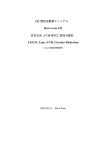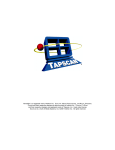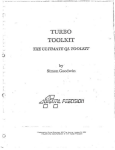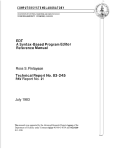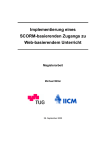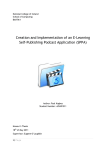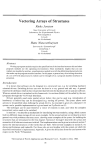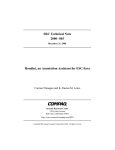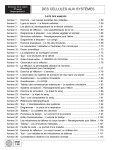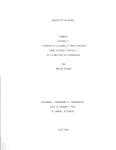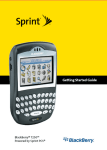Download The EXCHECK CAI System - Collected Works of Patrick Suppes
Transcript
THE EXCHECK CAl SYSTEM
by
JAMES McDoNALD
Institute for Mathematical Studies in the Social Sciences
Stanford University
EXCHECK is a CAl system which has been used at Stanford since 1975 to
teach over 250 students per year in elementary logic (through predicate
calculus), since 1976 to teach about 25 students per year in axiomatic set
theory, and since 1980 to teach a small number of students each year in
introductory Armenian. While it is a general purpose instructional system
used principally to create and present entire university-level courses,
EXCHECK can also be used to produce smaller modules for use as part of
other courses.
A primary goal in the design of EXCHECK has been the creation of a
system which can provide quality instruction in university-level courses,
particularly those of a mathematical nature. An important means to that
end has been the development of powerful packages which provide technological leverage to lesson authors by automating the dialog for large
classes of exercises.
A strongly related goal has been that the system be readily accessible to
both students and lesson authors. In particular, students are not presumed
to have knowledge beyond that normally assumed for the course being
taught, and lesson authors are not presumed to have skills beyond those of
a good instructor for the course. In general, attempts have been madeta
attain as natural a level of dialog as possible, throughout the system.
The work described here builds upon earlier work by Robert Smith, and later work by Lee
Blaine and James McDonald. Numerous people at IMSSS have contributed to the actual programming of EXCHECK, including Benjamin Cohen, Scott Daniels, David Ferris, Arvin
Lcvine, Lawrence Markosian, Jos Marlowe, Vesco Marinov, Teri Pettit, John Prebus, Ron
Robcrts, and William Sanders.
Special thanks arc· given to Arvin Levine for substantial editorial assistance on an earlicr
draft. The author also wishes to thank Patrick Suppes for comments on the final draft.
The research reported in this article was partially supported by National Science Foundation Gran" SED-74-15016 A02, SED-74-15016 A03 and SED-77-09698.
765
766
MCDONALD
1. GENERAL STRUCTURE
For the reasons given above, it is not surprising that EXCHECK is a
large system. Appendix A gives a rough description of the size of various
components in the runtime configuration for a single user.
The runtime EXCHECK program (that which actually prepares and/or
interprets lessons) has a modular design in which various functions have
been segregated into separate programs, as seen in Figure 1. Using features
inherent in the TENEX operating system (described in more detail below),
these programs run as a single large program with interacting components.
Lesson authors use the entire structure shown (and perhaps more), while
students run a program that is some subset of the graph descending from
the course driveL l
Vocal compiler"",
Text-editor
»~l:~~~
Audio
FIGURE
Prover
Reduce
Parser
1. Structure of runtime EXCHECK system.
All EXCHECK lessons are written in VOCAL (Voice Oriented Curriculum Authoring Language). The VOCAL compiler is a program which accepts those lessons and produces files of lessons acceptable as input to the
EXCHECK interpreter. The course driver interprets lessons prepared by
the compiler and governs each student's progress through the course. It
may invoke a proof checker to automatically present complex exercises
such as the derivation of proofs or the construction of explicit mathematical examples. The proof checker has access to a theorem prover and to
REDUCE, a program for algebraic reductions (Hearn, 1973). An audio
program is available to access the speech synthesizing capabilities at IMSSS
(Sanders & Levine, 1981), and each EXCHECK course has its own parser
to interpret complex input from the student.
In addition to being composed of interacting sub-programs, EXCHECK
also relies upon THRYEX, a program which prepares and tests the files
IFor the Armenian course, the proof checker, prover, parser, and reduce are replaced by
a component that provides drill and practice in Armenian. The audio facility is expanded to
include Armenian as well as English dialog.
EXCHECK CAl SYSTEM
767
used to describe a mathematical theory, plus other programs which handle
day-to-day maintenance and perform miscellaneous other chores. These
support programs (as well as EXCHECK proper) in turn rely upon the
TENEX operating system, as modified by IMSSS, and upon the excellent
text editors, message handlers, etc., which have evolved under TENEX.
The program clearly has been influenced by the TENEX environment.
In fact, many of the basic features of the program were patterned after similar TENEX conventions. Thus, it would be a mistake to analyze
EXCHECK (as it exists at IMSSS) outside of this context'
2. OPERATING ENVIRONMENT
The EXCHECK system currently runs under the IMSSS version of the
TENEX (multiprocessing) operating system on a dual-processor PDP-1O
computer system with 512,000 36-bit words of memory, 5 disk drives, 2
drums, and a multi-channel audio synthesizer (Sanders & Levine, 1981). A
special part of the operating system, called the student executive, simplifies
student contact with the computer and facilitates the management of information about the behavior of students in each course. The EXCHECK design reflects the TENEX environment by having independent programs,
referred to as forks, for its different functions. While EXCHECK does
make use of TENEX features specific to IMSSS, it does not have privileged
access to the operating system.
2.1 Student Executive
Students are a special type of user for IMSSS TENEX, with a login
procedure, called SEXEC, which limits them to exactly the course-program
for which they are registered. This login procedure is started by the system
whenever the space bar is typed on a free terminal. The student types his
or her special student number, then first name or nickname. In this and
following examples, student input is underlined. Other printing was done
by the computer. The special keys 'space bar' and 'carriage return' are
represented as '(space)' and '(return)', respectively.
<space>
Hi
Please type your number and name.
360John Smith<return>
2This does not imply that EXCHECK could not be run in other environments. Work on
transporting a significant portion of EXCHECK is proceeding, and methods have been developed to minimize and compartmentalize system dependencies. However, our only substantial
experience to date with EXCHECK has been that of running lessons for Stanford students
under the TENEX operating system on a PDP-lO which is enhanced by special hardware for
generating synthesized audio.
768
MCDONALD
After checking the student's number and name, SEXEC logs the student
in, updates information concerning use ,of the computer, and saves the
student's number and name in a system buffer assigned to that job. It then
determines the eIass the student is in, and overlays itself with the associated
course-:program. That program in turn reads the student's number and
name from the system buffer and proceeds with the curriculum. In general,
students ar~ not given direct access to the TENEXsystem unless their
course program explicitly provides such access.
Students are organized into eIasses associated with specific CQurseprograms, and a separate program maintains the database for student
users, creates classes, assigns students to classes, lists class members and
login statistics, and searches for students by name.
2.2 Data Saving
As Suppes and Sheehan (198Ia, 1981b) indicate, a great deal of data has
been collected on various aspects of student usage of EXCHECK. To facilitate system performance in maintaining student statistics, a special data
area on the disks, known as the DATSV area, was provided. This avoids
the overhead of creating files on the system's dynamic file structure for
data that are saved regarding the student's interaction with a CQurseprogram. A DATSV command given by EXCHECK writes out a 128-word
block of data to the DATSV area, including the date and time, information
about student progress, and links to any previous block saved. The total
DATSV area is accessed as a ring of four buffers, with each buffer holding
approximately two or three days of data for all students using EXCHECK.
The DATSV command automatically switches buffer areas as one becomes
full, and signals the operator that the data can be sorted and dumped onto
tape for long term storage and analysis.
2.3 TV-EDIT
TV-EDIT is a program developed at IMSSS for full screen text editing
(Kanerva, 1973). It is not part of the operating system per se, but ease of
use has made it the editor of choice at IMSSS. The VOCAL compiler is
given runtime access to TV-EDIT to facilitate rapid editing of lessons
during compilation sessions.
2.4 Forks
The ability of EXCHECK to run as a dynamic configuration of programs
depends upon the multiprocessing facility of TENEX to coordinate many
core images, called forks, as one program, without the need to program
explicit overlays. The availability of forks is not special to IMSSS.
When a student logs in, if SEXEC chooses EXCHECK to run the courseprogram, then the EXCHECK course driver is started. The course driver,
EXCHECK CAl SYSTEM
769
after checking the student's history, decides which forks to assemble for
that student. Some forks, such as audio, must be included from the beginning of the student's session if they are to be used at all, while others, such
as the theorem prover, can be added when they are actually needed, reducing the average size of the runtime system. Most forks in the EXCHECK
configuration can be run either as independent programs or as subservient
forks. Moreover, each fork can be written in a different programming language, allowing programs written at other sites, such as REDUCE (Hearn,
1973), to be readily incorporated for EXCHECK courses.
Another important use of forks is that programs too large [or one core
image (i.e., 256,000 words) can be split into parts and run in separate forks.
This is in fact the primary reason that the course driver and proof checker
reside in separate forks.
The fact that forks are largely autonomous is quite useful when using
them to coordinate programs written in different languages, but this same
feature can be a major disadvantage when using forks for the sale purpose
of splitting a large program into manageable pieces. For example, since
the course driver and proof checker do not have a common program control stack, EXCHECK does not attempt recursive calls from the proof
checker back to the course driver. Thus features such as BROWSE (described below), which use the course driver, cannot be directly accessed
while doing proofs in the proof checker. Instead, the student must first
defer the given proof to return to the lesson level, then BROWSE, then
return to the proof. Secondly, since the forks do not share complete data
about the state of the display appearing on the terminal, they occasionally
make mistakes when trying to restore that state, or when typing hints in
a proof.
While both of these problems are merely inconveniences which can be
remedied, they typify many problems inherent in using a small virtual
address space' The address space on a PDP-1O is IS bits, or 256,000 words.
A machine with a larger address space, for example 20 bits, or I million
words, would enable both the driver and proof checker to reside in one core
image, minimizing such problems. Having a larger address space, however,
probably would not significantly enhance or detract from the ability to
modularize the runtime configuration, particularly when interfacing
modules written in alternate languages.
A more significant problem with the IS-bit address space is that one
cannot arbitrarily divide a complex program into semi-autonomous pieces.
Thus, an inoidinate amount of effort was spent merely trying to make the
3The virtual address space. of a machine is determined by the number of bits available to
specify addresses in an instruction. It effectively limits the number of places (words or bytes)
that one can directly access.
770
MCDONALD
proof checker fit into one fork. Many features were truncated or abandoned simply because there was not room for them, which was often distressing. A larger address space would have freed that programming effort
for more directly constructive tasks. It is encouraging to note that many
newer machines have larger address spaces.
Much of the foregoing was intended to reflect some of the real problems
encountered during the development of EXCHECK. Thus, it should be
stressed that these problems, with the exception of the limited fork size, are
currently perceived as correctable nuisances, and do not appear as significant problems for day to day usage of EXCHECK. In general, it seems
clear that TENEX on a PDP-IO provided one of the best available operating
systems in which the development of EXCHECK might have occurred.
3. VOCAL
The VOCAL compiler is designed to accept course material written in
VOCAL, and to produce files suitable for interpretation by the EXCHECK
driver and its subservient forks. Smith (1981) gives a description of the
development of VOCAL.
A VOCAL course contains lessons consisting of exercises, which present
audio-visual lectures, ask questions, comment about answers, assign proofs,
check proofs, offer hints, ask for examples, check those examples, and perform other standard pedagogical operations.
The texts for lessons (and exercises) are created using TV-EDIT and
then are processed by the VOCAL compiler, which produces a set of files
in which each lesson is represented as a sequence of LISP-style S-expressions.
A small, but somewhat typical expression as entered by an author might
look like '(EXERCISE 10 (DERIVE "P --> P"))'. VOCAL would process this
to create the expression '(EXERCISE 10 (DERIVE (ARROW (P) (P))))',
which is suitable input for the runtime EXCHECK program. For detailed
descriptions of the structure of a VOCAL lesson, see the VOCAL manual
(Hinckley, Laddaga, Prebus, Smith, & Ferris, 1977), or the VOCAL guide
for lesson authors (Davis & Pettit, 1978). Weissman (1967) provides a description of the LISP programming language.
In general, each VOCAL expression has the general form '(OPCODE
ARGUMENT ... ARGUMENT)', where the OPCODE specifies a function
to be performed, and the arguments provide information to that function
about things to be done during its execution. These arguments can (recursively) be VOCAL expressions. VOCAL differs from LISP by providing
only a fixed set of functions, all related to the presentation of curriculum,
and by deliberately not providing the ability to define functions or declare
arbitrary variables. See Smith (1981) for details, but note that VOCAL is
not a general programming language.
EXCHECK CAl SYSTEM
771
Since the VOCAL compiler has runtime access to the text editor and to
the course driver, the process of writing and testing a lesson is highly interactive. Once the curriculum author has written an exercise, it usually takes
only minutes to compile it, test it in the driver, edit minor mistakes, and be
ready to compile it again. For efficiency, the VOCAL compiler contains a
highly truncated version of the course driver that can test major features of
a lesson without bringing the course driver or the forks below it into core.
The most important of these tests simply involves checking to see that the
screen will be formatted properly.
4. EXCHECK COURSE DRIVER
The EXCHECK course driver interprets lessons prepared by the
VOCAL compiler. It has three basic modes for curriculum presentation:
LESSON, BROWSE, and HELP. The curriculum materials for all three
modes are prepared by authors in VOCAL as described above. Because the
curriculum material is interpreted as recursively as possible, EXCHECK
admits powerful commands which allow students to BROWSE through
other lessons, or to invoke special HELP routines on their own initiative,
after which they return to their original lesson and exercise in the curriculum.
4.1 LESSONs
The LESSONs prepared for the main curriculum direct the general
pattern of progress for each course. Each lesson roughly corresponds to a
chapter in a book, and may be tailored to appear on a Teletype terminal,
a display terminal, or a display terminal with an associated audio channel.
If audio is generated, it may consist of prerecorded phrases, synthesized
prosodic speech, or some combination. In the Armenian course, prosodic
audio is used for English speech, while higher quality prerecorded phrases
are used for Armenian speech.
Usually students proceed sequentially through every lesson in a course,
but it is easy to set up special paths in which only selected lessons are given.
This feature is occasionally used to provide students in other courses with
a very brief overview of logic.
In the set theory course, there are currently three introductory and 18
normal lessons, all of which use prosodic audio. The basic logic course
consists of 29 lessons, with additional lessons in Boolean algebra, probability theory, and social choice theory available for students who pursue
grades of A or B. Each lesson in the basic logic sequence has both a display
version and a version using prosodic audio. Later lessons have either a pure
display version or a version using prosodic audio, but not both versions.
Where a choice exists among lesson modes, students can be automatically
_0;'-
772
MCDONALD
assigned some mode, or left to choose for themselves. Much of the data
collected about the logic course pertains precisely to such choices. See
Laddaga, Levine, and Suppes (1981) for details.
4.2 BROWSE
At most points in a course, a student can type 'BROWSE' to enter a
command level from which any exercise in the course can he presented. A
special flag is set at this level so that the interpreter presents the material in
a lesson without. requiring questions to be answered or problems to be
solved. The students can also review and manipulate material they have
created, such as stored versions of their proofs. The BROWSE facility is
intended to simulate a student's ability to skim forward or backward while
reading a textbook or notes.
4.3 HELP
Students who need particular advice or drill on some topic can type
'HELP' to enter the HELP system. Special lessons are available to address
particular points not covered by the general curriculum, such as use of the
computer system, hours for teaching assistants, and descriptions of the
inference rules available for doing a proof. The HELP system is graph
oriented, so that students can be guided toward the appropriate HELP
lesson provided they have some idea of what they want. In the example
below, a student wanted the computer to speak faster, and was able to find
the appropriate information in a fairly direct manner. The 'escape' key,
represented here as '$', does not show in actual use.
9*** HELP 110DE COMf1At>lD LEVEL
type
****
(Type 0'"" to exit)
for help on
AD!1IN
SYSTEM
LANGUAGE
EXCHECK
ALPHA-LIST
Administrative matters
Use of the computer system
The language of Logic and Set Theory
Use of the proof checker
An index to an alphabetical listing of all HELP
topics (with descriptions) is displayed
[This will cause a new screen with the next frame to appear.]
****
HELP MODE COMMAND LEVEL
type
AUDIO
BROWSE
CTRL
DERIV-FORMAT
.pOl'
****
(Type OK to exit)
help on
Problems with the audio s~stem
Using Browse Mode (AB)
Control commands
How to change derive format
773
EXCHECK CAl SYSTEM
DISPLAY
How to use display features
GRIPE
HELP-HAS
How sen.d a complaint or suggestion
What the Help System contains
How to use the Help System
The various types of exercises in the course
Functions of the special (black) keys
HELP-USE
EXERCISES
KEYS
NE~"S
AD:"lIN-CMD-LIST
How to ask for news an the course
Some administrative commands
[Again, this causes a new screen to appear.]
****
HELP MODE COMMAND LEVEL
type
****
(Type OK to exit)
for help on
SPEED
Controlling the speech rate
GRIPE
How to send a complaint or suggestion
[Now a brief lesson is presented showing how to use
speech. When finished, it returns to this HELP level.]
****
HELP MODE COMMAND LEVEL
****
t
S to change the rate of
(Type OK to exit)
for help on
typ e
ADMIN
SYSTEM
LANGUAGE
EXCHECK
ALPHA-LIST
Administrative ~atters
Use of the computer system
The language of Logic and Set Theory
Use qf the proof checker
An index to an alphabetical listing of all HELP
topics (with descriptions) is displayed
[The screen is then restored and the student is returned to the exact prompt at
which HELP was originally typed.]
In the next example, the student enters HELP and then goes directly
to a HELP lesson on the ESTABLISH rule. Thus we can see that the graph
is a guide, not a restriction.
*HELP$
~***
HELP MODE COMMAND LEVEL ****
type
ADMIN
SYSTEM
LANGUAGE
EXCHECK
ALPHA-LIST
*EST$ablish
TOT'
(Type OK to exit)
help on
Administrative matters
Use of the computer system
The language of Logic and Set Theory
Use of the proof checker
An index to an alphabetical listing of all HELP
topics <with descriptions) is displayed
774
MCDONALD
[The student enters a HELP lesson \vhich explains how to use the ESTABLISH rule
of the proof checker.]
Within HELP, lessons are presented as in the main curriculum, except
that at any point the student may simply leave the HELP lesson. This
allows curriculum authors to provide remedial lessons in such a way that
students who do not need them never see them. The easy exit also prevents
students from being trapped in a HELP lesson they no longer wish to pursue.
The set theory course makes extensive use of HELP lessons, since students come in with a wide range of backgrounds, dividing particularly into
those who have and have not taken the logic course.
The logic course makes essentially no use of the HELP facility, primarily
since its curriculum was complete by the time the HELP facility was developed. The logic curriculum, moreover, is meticulously structured to
explicitly introduce students to every feature and concept they will encounter, and provides numerous review exercises which summarize important conventions. The ability to BROWSE through these review exercises
has thus largely obviated the need for HELP lessons.
4.4 Additional Driver Functions
In addition to the three major modes of curriculum presentation,
EXCHECK has some ancillary features which provide useful functions.
Students can read news intended for the entire clas's, or personal messages
intended for them alone. They can send gripes (messages) to the course
authors, teaching assistants, or programmers. All news, from the first day
of class, can be accessed in reverse chronological order. Recent personal
messages are removed, but only when the student next logs out normally.
Gripes range from real complaints about the course or program, to notifications of spelling or stylistic errors, to messages for particular staff members. Students are also encouraged to use' it at the end of the course to
indicate the grade they have earned (since a mastery approach is used, they
know their grade). This provides a useful cross-check with the computer's
records.
4.5 Recursive Interpreter
The organization of EXCHECK to allow BROWSing and HELPing
has advantages over tutorial texts and other sequential presentations of
material, since students can decide when, where, how much, and what sort
of help they need, without losing their position in the main curriculum.
When students return from NEWS, GRIPE, BROWSE or HELP, their
screen is usually refreshed to display the material that was there just before
they selected one of the other modes, and they are able to respond to whatever prompt awaited them as if they had never left. The ability to return to
the exact place which one left earlier is a general feature of recursive
EXCHECK CAl SYSTEM
775
programs, and EXCHECK was designed as a recursive interpreter largely
to facilitate this.
5. VINPUT
Because a student might be answering a question in one curriculum
mode while a different question in some other mode is still pending, the
routines which accept input need to be recursive to avoid losing their
context. HELP, BROWSE, and related commands are designed to be available as generally as possible, so ideally every input routine in EXCHECK
should be able to recognize and execute these commands. For these reasons
and others discussed below, all the in put in EXCHECK is obtained using
one general routine called VINPUT.
One immediate advantage of using VINPUT is that student interactions
now proceed in a uniform manner. This simplifies the documentation of
features, and minimizes the knowledge students must have of EXCHECK.
Features have -been introduced to reduce the amount of typing required,
to provide assistance in determining the options available, and to offer a
means through which the student can accesS HELP, BROWSE, and other
special features. Additionally, prompts, comments, and error messages are
stored separately from the program's code, so it is easy to update them and
to provide alternative styles such as 'terse' and 'verbose'.
5.1 Input Recognition
In every place where the permissible options can be listed, recognition
is used to minimize the number of characters a student must type. A student can type just the first few characters of an option followed by the 'escape' key and VINPUT will attempt to recognize the option, extending the
student's input as it does so. Thus, if very-long-option-a and very-longoption-b were the only alternatives, one possible studentjEXCHECK interaction would be:
*V$ery-long-option-D$
The student's input is underlined, and '$' indicates the 'escape' key, which
does not print in actual practice.
5.2 Question Mark Response
Coupled with the recognition feature is a question mark response
facility that will list all possible options given the current input. Thus the
example above could have proceeded as:
*V$ery-long-option-2
very-long-option-A
very-long-option-B
*very-lon9-option-~
776
MCDONALD
Of course, instead of continuing with B, the student could have deleted
characters and tried again if some third command were intended.
The question mark facility works more elaborately if a question mark is
typed without preceding characters. The assumption here is that the
student does not know exactly what is available or what is expected. A new
prompting level (indicated to the student by'?? ') is entered, and commands
are treated as they would be at the main prompt, except that instead of
generating actions, they generate descriptions of those actions. The motivating concept is that a command entered when the prompt is '?? ' will
provide a quick description of what that command would do at the original
place where question mark was typed. For example, 'NEWS' typed at any
normal prompt will let the student read the news, but at the ?? prompt,
it will generate:
??NE$ws is always available and allows you to read the news.
Typing the 'escape' key at this prompt will give a list of all the options legal
when the original question mark was typed. For example, at the top level
of the proof checker, all the proof commands appear, followed by the
general commands. The ?? prompt repeats until the stlldent types 'ok' to
leave it.
The question mark facility was added relatively late in the development
of EXCHECK, and the online curricula do not really mention it. Moreover,
data have not been collected on the use of this feature, so it is difficult to
assess its utility for students.
5.3 Control Commands
VINPUT always recognizes certain control commands, such as HELP,
BROWSE, NEWS, MESSAGE, and GRIPE. The appropriate routine is invoked recursively, if possible, after which the student's screen and position
in the course are restored. VINPUT also recognizes certain control characters, 'control-A' (t A), 'control-B' (t B), etc. which allow the student to
logout, abort the current operation, enter browse, refresh the screen, repeat
the last action, etc.
Speech rate. Control-S permits the student to modify the rate at which
the synthesized speech is spoken. Originally, the speech rate is set to be
about 10% faster than the rate at which words were recorded. The student
can vary this rate anywhere between a rate twice that of the recording and
one 20% slower than the recording.
Line editor. Control-V invokes a line editor that allows a student to
insert, delete, and append characters. If it is typed immediately following
some input, that input is edited. Otherwise, each t V retrieves the next
older input appropriate for the current prompt. The record of student
input which t V accesses can also be used to reconstruct almost exactly what
EXCHECK CAl SYSTEM
777
the student typed, a valuable aid in diagnosing any problems that arise.
Guess. Control-G can be used at many prompts to ask the computer to
guess. This is most meaningful in exercises where some goal or subgoal is
currently pending (see Blaine, 1981), so that some context exists for making
a guess. Its use in such contexts can drastically reduce the number of
characters a student must type, thus reducing typing errors as a source of
distraction.
Hint. Control-H at any prompt will check to see if any applicable hints
are available. Currently these hints are mainly entered by the lesson author,
but dynamically generated hints are possible. Hints are offered in succession and many hints may be available for a given problem.
Uniform exit routine. Control-L was intended to allow the student a
graceful exit from any situation that might arise in EXCHECK. It should
be an immediate interrupt, to abort any other EXCHECK processing. Instead, for now only VINPUT and the theorem prover check to see if it has
been typed. Occasionally, a student may present EXCHECK with an enormous inference not handled by the theorem prover. For example, problems given to BOOLE can grow exponentially in the time required to
answer them, as new sentences are added for consideration. Students may
also simply stumble onto a programming error which leads to infinite
looping. Currently, the only remedy in such cases is to have a staff member
log the student out remotely, after which the student can log back in.
Unfortunately, work can be lost in this process, and if a staff member is
not available, the student is helpless. This i~ the most significant problem
left in the user interface. t L does work well in those cases where students have begun to enter a command, only to change their mind halfway.
Since VINPUT responds to l' L, it is recognized at any input point.
Logging out. Control-Z is designed to finish the current operation,
record the student's status in the course, and terminate the session. The
saved status will be used when the student next logs in to restore the context that existed prior to logging out. Files which keep track of a student's
status are periodically updated while that student is working, to minimize
the amount of work that the student must repeat if the computer crashes
while the student is logged in. Even if a student's file is accidentally lost or
garbled, it is possible for a teaching assistant to adjust that student to the
proper course location.
6. PARSERS AND GRAMMARS
The language required for formal discourse in logic, and more dramatically, those needed for informal discourse about set theory or proof
theory, require input grammars of significant complexity. Output grammars of comparable complexity are also needed to provide flexible presentations of the mathematical objects generated by EXCHECK.
-:or-
MCDONALD
778
6.1 Parsers
To parse complicated logical or set theoretical expressions from the
student, the parser for that course is invoked as a separate fork. Our parsers
for the mathematical courses currently use the Cocke-Younger algorithm
(Aho & Ullman, 1972)4
Simple formulas parsed for various courses include:
Set Theory
(\fx) (x E A ---7 X E B)
For all x, if x is in A then x is in B
Proof Theory:
ZF*
r
(\fx)x ~ x
ZF* proves that for all x, x = x
The mathematical parsers are context free for a given theory. However,
EXCHECK provides the ability to switch theories within a course and thus
alter the interpretation of expressions.
Beyond meeting the technical requirements for courses such as proof
theory, the parsers provide reasonable flexibility in the style of input. Thus,
"(\fx)(x E B)" and "for all x, x is in B" will both be parsed as the same
formula. However, "everything is in B", which is also a good paraphrase,
cannot currently be recognized because it violates certain restrictions inherent in context-free languages.
A conjecture this author endorses is that people conversing in a system
with mathematically clean rules for dialog will adapt very quickly to it, even
if they are not explicitly aware of the rules. Context-free languages seem
to form a natural plateau at which people can converse without making
mistakes, and without feeling unduly restricted.
6.2 Output Grammars
We have put a significant effort into presenting logical and mathematical
material in a clear and flexible manner. As one small aspect of this, our
terminals were modified to include an extended character set using Greek
letters, \fs, and other mathematical symbols. At a more fundamental level,
we have designed grammars that provide for a number of modes of output.
These output grammars reside in the proof checking fork since most formulas are generated there.
A student can specify several dimensions of output style. For example,
there is a choice between formal and informal output. If a student wishes
4A system for writing and testing grammars using the Early algorithm (also in Aha &
Ullman, 1972) was largely completed, but never actually incorporated into EXCHECK proper.
EXCHECK CAl SYSTEM
779
to print the definition of suhset, EXCHECK will normally print the definition in a formal style:
A
~
B
<-7
(\Ix) (x E: A
-;>
x E: B)
The student can also request an informal style, in which case EXCHECK
will print:
A is a subset of B
if and only if
for all x, if x is in A then x is in B
Students are free to alternate between formal and informal styles. They
can also decide whether EXCHECK should print top-level universal quantifiers. In the above examples, EXCHECK has not printed tfie top level
universal quantification of A and B.
For complicated terms or formulas, the student can specify parametric
abbreviations to simplify the form of the expressions printed. The specified
abbreviations are also recognized by the parsers, reducing the typing needed
to input new expressions. For example, "x hits y" could be used to abbreviate "x E A and y E: Band F(x) = y" in both input and output.
7. PROOF CHECKING FORK
A primary student activity in the EXCHECK courses is the presentation, in dialog with the instructional program, of mathematical reasoning
(proofs) to be checked for correctness. Blaine (1981) gives an extensive
description of this activity. In fact, the most interesting aspects of the
EXCHECK system are the procedures and the underlying theories of mathematical reasoning that permit this interaction to take place at a fairly
natural semantic level in a style approximating standard mathematical
practice. These aspects of EXCHECK include natural language facilities,
natural deduction based proof procedures, theare-m provers, decision procedures for some simple mathematical theories, procedures for analyzing
and summarizing proofs, and procedures for conducting dialogs about
some elementary mathematical structures. See Blaine (1981) for a detailed
analysis of these features, and for sample proofs.
7.1 Proofs
In the set theory course, student proofs are entered in a top down fashion, in the sense that proofs are recursively broken down into smaller proofs.
This is in keeping with standard mathematical practice and reduces the
degree to which students are likely to generate correct but pointless lines.
It also vastly enhances the computer's ability to analyze the student's progress so far and to provide direction for further progress. The effective use
780
MCDONALD
of t G (guess) within a proof depends strongly upon this principle. In the
logic CQurse, proofs are still entered in a linear fashion, primarily because
the curriculum was complete before the goaling mechanisms were implemented.
Another feature of standard mathematical practice is that proofs are
usually only sketches of the main line of argument. Distracting detail is
omitted. The proof procedures in EXCHECK match natural procedures
well enough that students need not enter significantly more lines than those
which would occur in a· natural proof. Again, see Blaine (1981) for a more
detailed discussion of this matter, and Suppes and Sheehan (l98Ia, 1981b)
for quantitative data on the lengths of proofs.
Since typing formulas is another form of distracting detail, EXCHECK
has been designed to minimize the typing involved in entering formulas.
Many proof procedures automatically generate the formula tobe inferred.
The students can access a substantial list of axioms, definitions, lemmas, and
theorems by name using VINPUT recognition. Expression designators.
such as FM3:2 and TM3:2:1, have been provided to allow a student to
access terms or formulas from previous lines. For example, FM3:2 designates the second subformula of line 3 and TM3:2: I designates the first
term of that subformula. A line editor is available for modifying previously typed formulas, commands, etc. Effective use of the proof commands, theorem lists, expression designators, and line editor can reduce a
stqdent's typing by 75% or more.
In the course of a term, logic students will typically do about 150 nontrivial proofs. Set theory students are likely to finish about 50 substantial
proofs. These figures will vary depending upon the grades desired, and
the extent to which students perform extracurricular proofs for their own
pleasure or curiosity. It can safely be said that those who finish a course
have almost always improved their ability to give valid proofs. Students will
gripe about bugs in the program, the time required to complete the course
(logic is a five-unit class), even the condition of the terminal rooms, but I
think we have never received a gripe to the effect that a student has not
learned how to do proofs.
Of course, in set theory, the emphasis should properly be on the mastery
of mathematical concepts, and not merely on the ability to prove various
theorems, however adeptly. Students in that course, particularly those who
are exceptionally well prepared, have often felt that they were spending
relatively too much time learning how to do proofs in EXCHECK, and too
little time learning the concepts of set theory.
Much of this frustration probably arises from simple lack of power in the
EXCHECK proof checker. In particular, simple truths about functions can
be extremely obvious to the student, and yet require many minutes to prove.
Additional decision procedures (analogous to BOOLE, TAUTOLOGY, and
EXCHECK CAl SYSTEM
781
TEQ) which could quickly confirm such propositions would perhaps alleviate most of that frustration.
7.2 Construction Exercises
A different class of exercises require the student to specify some small
finite model that satisfies a given set of conditions. A typical exercise might
proceed as follows. As before, student input is underlined, and '$' represents the 'escape' key, which does not show in practice.
Construction Exercise:
A =
{
1t
2,
3 }
B
{
4,
5,
6,
7 }
Give an injection F from A into B.
Wrong, because the domain of F is not a subset of A.
Why$ Because 4 is in the domain of F and 4 is not in A.
* 50$ the domain of F is not a subset of A
* 50$ the domain- of F is not ellual to A
* 80$ F is not an inJection from A into B
* ok$
*
Construction Exercise:
A = { 2,
4,
6 }
B
{ 4.
S,
6,
7 }
Give an injection F from A into B.
F
"tV
F = { <1,4:>, <:2,5:>, <:3,6> <:4,7> }
F = { <g,4>, <1,5)-, <e,,6>
}!.
Very good.
The computer is asking the student to enter a set, to be called F, which
will satisfy certain conditions involving the given sets A and B. Since the
student's first answer is wrong, the program analyzes why the answer was
incorrect and stores this information in the form of an internal graph. It is
then ready to enter a simple dialog with the student which is based upon
the chain of reasoning used to find the student's mistake. After the student
understands the mistake, a very slightly modified exercise is presented, and
the student uses the line editor to quickly modify the old answer to get a
correct answer for the new exercise. The computer then acknowledges the
correct answer.
The construction exercises were designed late in the development of
EXCHECK and have not been incorporated into the curricula for any
782
MCDONALD
course. Nonetheless, the ability of EXCHECK to check this type of exercise
has interesting potential. In particular, the ability to carryon graph oriented
dialogs, while primitive here, seems to he an avenue strongly worth pursuing. Given the highly structured environments to be found in mathematics
courses, it would seem to be quite natural to build graphs relating various
notions such as rules, proofs, counterexamples, models, etc. Designing a
program that could make effective use of such graphs, leading students
from one related notion to another, could he a very productive project.
7.3 Ease of Exercise Creation
An important point to notice about EXCHECK (perhaps the most
important) is that both construction and derivation exercises are extremely
easy to create. The lesson author need only state the problem, leaving all
interaction with the student under control of the proof-checking fork. The
construction exercise above was generated from a VOCAL expression very
similar to the following question and answer expression:
(QINIT ((PROVIDE (A "[1,2,3]") (B "[4,5,6,7]"))
(REQUEST "Give an injection F from A into B." (F)))
A (ASSESS "F:A inj B"))
A fairly typical proof could be· assigned by merely entering the VOCAL
expression '(DERIVE "If A < Band B < C then A < C")', although in
practice one would probably restrict the theorems available, and possibly
provide hints.
The brevity of these expressions, contrasted with the range and variability of the dialogs they generate, provides a clear example of the technological leverage which is possible in CAl systems.
7.4 Play
In fact, EXCHECK does enough of the work involved in creating and
evaluating derivation exercises that students can simply type 'PLAY' to
enter a mode in which they themselves specify exercises. In the set theory
course, they may choose an arbitrary formula to prove, or ask to prove one
of the predefined theorems. When proving arbitrary formulas, they are
allowed to use any theorem in the course, but when proving theorems
chosen by number or name, they are restricted to using axioms, definitions,
and theorems that precede the theorem to be proven. Many of the proofs
which students do for credit are chosen through PLAY, providing flexibility in the assignments. The PLAY command is also useful when students
are learning EXCHECK, and encourages curious students to explore.
Construction exercises are not yet available within PLAY, partially for
technical reasons, but primarily for lack of time.
EXCHECK CAl SYSTEM
783
8. RELATION TO CURRICULUM
It has now been mentioned more than once that certain features have
not been made available to students because they were implemented after
curriculum development was complete. This typifies a significant general
problem for CAl courses-while it may be relatively easy to create new
features, it can often prove quite difficult to introduce such features in
a pedagogically sound manner.
For example, there is little doubt that the goaling mechanism is an important and useful feature of the set theory course. In the logic course,
however, one can at least argue the point that providing such a powerful
feature might detract from the students' participation in the organization
of proofs. Even if we assume that goaling is a good feature for this course,
there remains the formidable problem of rewriting hundred of pages of
VOCAL lessons that make explicit assumptions about the structure of
proofs. By paying meticulous attention to the detailed operation of the
proof checker, lesson authors for the logic course have made it extremely
easy for students to understand and use that machinery. Concomitantly,
however, they have made it quite difficult to modify the proof checker without meticulous attention to the curriculum. 5
This problem will undoubtably be a major one facing continued development in any system like EXCHECK. Given the largely unstructured nature of the text appearing in typical curricula, a detailed analysis of this
problem would go far beyond the scope of this article. One partial solution,
however, would be to mechanize the introduction of course features by
implementing a player piano type of exercise. The main idea is that the
program would reproduce sessions done by expert users, possibly generating questions along the way to see that students could predict what was
legal and useful to do. New features would then be documented primarily
by having experts run through enough such sessions to illuminate all the
options. All such old sessions could be mechanically reexecuted to insure
that they still worked. Fundamental pedagogical issues might remain, but
the technology for implementing chosen features would be enhanced.
9. IMPLEMENTATION ISSUES
In implementing any program, the moment arrives when one must
commit to specific languages, data structures, and algorithms, all too
often before the experience is available to know what the best choices will
Sit was distressing at one point to fix a deficiency in one of the commands, only to discover
much later that one exercise described that deficiency in great detail, and explicitly advised
students not to use that command in the manner in question!
784
MCDONALD
be. In fact, there is a widely circulated bit of folk wisdom that to do a program right, one must first write it and make it completely operational, then
start over from scratch and do it again. Of course, such luxury is rarely
possible, and possibly never budgeted.
The design of EXCHECK has been in large measure quite good. The
design of VOCAL, as described in Smith (1981), was well conceived, and
the largely modular structure of the programs has facilitated development.
In fact, problems have arisen not so much from flaws in the conceptual
design of EXCHECK, as from lack of provision for the dynamics that occur
when many people work on a large program. Thus, the final program
works well and works reliably, but the path to that success has been more
troubled than necessary. The primary problem stems from the use of a
noninterpretive language for the generalirnplementation. A second set of
problems arose concerning the actual display of characters on the screen,
and finally a myriad of minor problems have arisen from lack of programming conventions, -or lack of adherence to them.
9.1 SAIL
While VOCAL has a LISPish syntax, the actual language used to
implement the course driver and proof checker is SAIL (Stanford Artificial Intelligence Language), a dialect of ALGOL with numerous supported
data types-in particular, convenient and efficient string routines (Reiser,
1976).
When EXCHECK was first being written, it was envisioned that string
manipulations would be a predominant activity. SAIL and various LISP
dialects were the most promising candidates for the implementation, and
since LISP dialects in general were poor with strings, SAIL was chosen.
An S-expression package was added to accommodate the LISP syntax
VOCAL, and to facilitate logical operations on proofs, and other abstract
structures. This package contains such LISP routines as CONS, APPEND,
READ, and even MAPCAR, which basically manipulate S-expressions, but
it does not perform operations such as PROG and LAMBDA binding, or
ERRORSET protection, which pertain to the control of LISP programs.
The normal SAIL routines have proven quite nice for most system interfaces and string manipulations, while the S-expression package facilitates
logical operations on proofs and other complex data structures.
This system does work (EXCHECK currently runs in it!), but in retrospect, it seems that some dialect of LISP would have been a far better
choice than SAIL. The primary reason for this observation is that LISP
has an. interpreter, and supports the compilation and loading of individual
functions. The time saved in the program debugging loop between function editing and testing would have been more than ample to put an efficient string package into whatever LISP dialect was chosen.
01"\
EXCHECK CAl SYSTEM
785
A second major disadvantage of SAIL compared to LISP is that it uses
lexical, not dynamic, scoping of variables. As a result, the recursiveness
of the course driver is not ideal, and it can become quite complicated to
insure that the values of all appropriate variables are properly saved and
restored when shifting to a different context.
A final unfortunate disadvantage of the current system is that the Sexpression package resides in SAIL but is not known to the compiler.
Programmers must therefore explicitly protect S-expression variables from
the garbage collector, which would otherwise cannibalize their contents
for use in other structures. Good programmers have made mistakes in this
system, and confused or inexperienced programmers have wreaked havoc.
Mysterious garbage collection problems accounted for perhaps 90% of all
debugging effort during a two-year period. The SAIL compiler could
perhaps have been augmented to be cognizant of the S-expression package,
but the time for that almost certainly would have exceeded the time spent
adding good string facilities to some LISP dialect.
As something of a postscript, a LISP version of the part of EXCHECK
adequate to present the basic logic course is nearing completion. 6 Preliminary results with about 10 students seem to verify the intuitions stated
above. The only major disadvantage to using LISP seems to be an increased
use of memory and CPU time, but substantial optimizations are envisioned
which may eliminate that disadvantage.
9.2 Display Features
The second problematic area in the implementation revolves primarily
around screen management. The Datamedias we use have a 24 by 80 character screen, which limits the amount of text that can be shown at anyone
time. The template mechanism in VOCAL goes a long way towards clarifying screen management for lesson authors, but does not resolve detailed
issues regarding the format of proofs, menus, and other internally generated structures. The ability to recreate the exact screen image or replay
recent material also must be embodied by some definite implementation.
The current display code in the course driver and proof checker is
adequate to the task, but contains many ad hoc routines written to address
specific problems. The situation has improved considerably in the transportable LISP version being developed, but a truly elegant solution still
eludes us. Languages such as Small Talk (Goldberg & Kay, 1976) and LISP
Machine Lisp (Weinreb & Moon, 1979), which provide windows and screens
as basic data types, seem to have made an important step in the right
6Professor Tryg Ager, of the State University of New York at Binghamton, has been 'working
to develop a transportable version of the logic course.
786
MCDONALD
direction. Given the time spent designing and implementing screen management for any substantial CAl course, this would seem to be an area
worthy of further study. In fact, leaving graphic display aside, it would be
most gratifying to see a general purpose LISP package evolve that has an
intuitive and simple syntax, yet is suitable for presenting fairly arbitrary
text patterns on a wide variety of terminals.
9.3 Programming Conventions
One cannot work on a large system for many years without being struck
by the need for good programming conventions. To condense some of
OUT experience, better adherence to the following rules (among others)
would have significantly reduced the time spent debugging and modifying
EXCHECK:
1. Use macros or defined functions to access data structures. Far too often,
people explicitly took the first or third element of some structure on the assumption that they knew how that structure was organized, and that the
structure would not change. The result now is that such structures dare not
change.
2. Use descriptive function and variable names. Routines called FI or F2 which
used SEI through SEI2 as variable names rapidly became opaque. In fact,
sometimes the only way to safely modify these routines was to replace all
such names with mnemonic ones, tediously reconstructing the original programmer's intentions.
3. Copiously document side effects. The generation of delicate side effects by
various routines seems to be a pervasive feature of large systems. Lack of
proper documentation about such effects has caused tremendously obscure
errors to occur when such a routine was altered in what seemed to be an innocuous manner. I/O routines seem particularly prone to this problem, since
the state of the screen is a fairly hidden effect when looking at code.
4. Avoid delicate features, unless they are well understood. As mentioned before,
the S-expression package was extremely convenient when used properly, but
created code analogous to a minefield when used improperly.
While the direct cost of ignoring such conventions was significant and
fairly obvious to appreciate, it is important to note that the worst effect of
such problems may have been due, not to their direct costs, but to the sometimes debilitating effect they had on programmers' normal efforts. For
example, ~hen undocumented side effects were feared, it could take quite
some time to verify that none of the hundreds of pages of code in other
files were likely to be affected by a small intended change in one routine.
Likewise, when a routine needed minor maintenance, but appeared
opaque, it often seemed easier to completely rewrite it than to decipher the
old code, an approach that som'etimes introduced new classes of errors.
In short, our experience with EXCHECK, both positive and negative,
has shown that adherence to good programming conventions is perhaps
EXCHECK CAl SYSTEM
787
not critical to the implementation of an initial program, but quickly becomes a dominant consideration in programs intended for long use and
evolutionary improvement. This is a warning readers should ignore at
their peril.
10. SUMMARY
The EXCHECK system has proven moderately flexible and quite easy
to use. Both audio and visual modes are available for lesson presentation,
and copious data have been collected and analyzed on the effect of such
redundancy.
For the students, powerful CAl modules perform detailed answer analysis, and lessons are interpreted recursively, giving rheIn significant freedom
in choosing what to do next. Proof procedures make it possible to do proofs
in a rather natural fashion, while input parsers and output grammars provide multiple styles for representing and simplifying formulas.
For course authors, VOCAL allows lessons to be written and tested in
interactive sessions, using sophisticated editors and debugging facilities.
Moreover, forks are dynamically assembled at runtime, allowing each course
designer important freedom to add novel features as they become available,
even if no specific provision was originally made for them.
Problems as noted throughout still remain. EXCHECK was a prototype
system, and thus bound to encounter mistakes in design, development, and
documentation. However, the demands of providing ambitious students
with courses worthy of university credit have clarified and limited such mistakes in an extremely sharp way.
The author would in no sense claim that EXCHECK is the ultimate
pedagogical vehicle. Nonetheless, it does provide a good vehicle given the
current state of the art, and the experience gained from EXCHECK should
prove most valuable in the design of newer systems.
REFERENCES
Aho, A. V., & Ullman, J. D. The theory of parsing, translating, and compiling (Vol. 1).
Engelwood Cliffs, N. .J.: Prentice-Hall, 1972.
Blaine, L. Programs for structured proofs. In P. Suppes (Ed.), University-level
computer~assi~ted instruction at Stanford: 1968-1980. Stanford, Calif.: Stanford
University, Institute for Mathematical Studies in the Social Sciences, 1981.
Davis, M., & Pettit, T. Using VOCAL: A guideIoJ" authors (Tech. Rep. 296). Stanford,
Calif.: Stanford University, Institute for Mathematical Studies in the Social
Sciences, 1978.
Goldberg, A., & Kay, A. (Eds.) Smalltalk-72 instruction manual (Tech. Rep. SSL 76-6).
Palo Alto, Calif.: Xerox Palo Alto Research Center, 1976.
Hearn, A. C. REDUCE 2 user's manual (2nd Ed.). Salt Lake City: University of Utah,
1973.
788
MCDONALD
J., Smith, R. L., & Ferris, D. VOCAL: Voice
Oriented Curriculum Author Language (Tech. Rep. 291). Stanford, Calif.: Stanford
Hinckley, M., Laddaga, R., Prebus,
University, Institute for Mathematical Studies in the Social Sciences, 1977.
Kanerva, P. Tvedit manual. Unpublished manuscript, Stanford University, Institute
for Mathematical Studies in the Social Sciences, 1973.
Laddaga, R., Levine, A., & Suppes, P. Studies of student preference for computerassisted instruction with audio. In P. Suppes (Ed.), University-level computerassisted instruction at Stanford: 1968-1980. Stanford, Calif.: Stanford University,
Institute for Mathematical Studies in the Social Sciences, 1981.
.
M.LT. Laboratory for Computer Science Mathlab Group A1ACSY1\;IA r~j"erence
manual (Version 9, 2nd printing).Camhridge, Mass.: Massachusetts Institute
for Technology, 1977.
Reiser, J. F. SAIL (Stanford Artificial Intelligence Laboratory Memo AIM 289).
Stanford, Calif.: Stanford University, Stanford Artificial I ntelligence Laboratory,
1976.
Sanders, W. R., & Levine, A. The MISS speech synthesis system. In P. Suppes (Ed.),
University-level computer-assisted instruction at Stanford: 1968-1980. Stanford, Calif.:
Stanford University, Institute for Mathematical Studies in the Social Sciences,
1981.
Smith, R. L. VOCAL: A case study in the methodology of the design of authoring
languages for computer-assisted instruction. In P. Suppes (Ed.), University-level
computer-assisted instruction at Stanford: 1968-1980. Stanford, Calif.: Stanford
University, Institute for Mathematical Studies in the Social Sciences, 1981.
Suppes, P., &Sheehan,j. CAl course in axiomatic set theory. In P. Suppes (Eel.),
University-level computer-assisted instrtu;tion at Stanford: 1968-1980. Stanford, Calif.:
Stanford University, Institute for Mathematical Studies in the Social Sciences,
1981. (a)
Suppes, P., & Sheehan, J. CAl course in logic. In P. Suppes (Ed.), University-level
computer-assisted instruction at Stanford: 1968-1980. Stanford, Calif.: Stanford,
University., Institute for Mathematical Studies in the Social Sciences, 1981. (b)
Weinreb, D., & Moon, D. LISP machine manual. Cambridge, Mass.: Massachusetts
Institute for Technology, 1979.
Weissman, C., LISP 1.5 primer. Belmont, Calif.: Dickenson, 1967.
APPENDIX A
Structure and Size of EXCHECK
This appendix describes the size of the EXCHECK program on a module by
module basis, and offers some translation into IBM terminology.
EXCHECK is an extremely large program. Including the compiler, there are
seven forks in the system, where each fork can be thought of as a nearly autonomous
program that has an entire virtual address space available to it. Since this virtual
address space consists of 256,000 36-bits words, the-system has available a combined
address space of 1.8 million PDP-I0 words, or about 8 million 8-bit(lBM) bytes.
Only three of these forks are nearly full of code, and large segments of code are
shared among many of the forks. Taking these factors into consideration, the program can be expressed as roughly 600 K (i.e., 600,000) words of code and another
300 K words of work space, for a total of about 900 K words, or 4.4 megabytes.
The following table gives a rather detailed analysis of two important forks, and
then a grand summary for all forks. The detailed analysis performs rough divisions
789
EXCHECK CAl SYSTEM
into code (sharable or reentrant memory) and variables (private or non-reentrant
memory). Numbers are given in multiples of K (i.e., 1.028) 36-bit words.
--.",
Size of Components in Course Driver
Space used (in K words)
Component
Code
VOCAL interpreter
Logical routines
Audio
Help package
High level input
High level output
I/O utilities
Fork communication
Basic SAIL routines
S-expression package
Global data structures
Workspace
I/O buffers
Mise (debugging, etc.)
12
3
7
2
8
4
5
16
5
1
0
0
15
0
0
1
3
1
1
1
10
1
4
5
26
8
14
Total size of Course driver
80 K
75 K
2
Variables
Size of Components in Proof Checker
Space used (in K words)
Component
Code
Initialization
V DeAL interpreter
Proof checker
Logical utilities
Audio
High level input
High level output
I/O utilities
For k communication
Basic SAIL routines
S-expression package
Global data structures
Workspace
I/O buffers
Theorem names
Misc (debugging, etc.)
4
Total size of proof checker
0
19
15
6
11
15
4
5
16
5
3
0
0
0
25
131 K
Variables
0
3
2
0
1
1
1
1
10
1
4
4
28
8
5
1
67 K
790
MCDONALD
Sizes of Forks (sub-programs) in EXCHECK
Fork
PDP-lO words
(36-bit words)
Vocal compiler
Course driver
Proof checker
Theorem prover
Audio
Parser
Reduce
153
155
198
211
132
56
63
K
K
K
K
K
K
K
Total
968 K
IBM equivalent
(8-bit bytes)
690
700
890
950
600
250
280
K
K
K
K
K
K
K
4,360 K
The equivalents given are conservative, since they assume that the same number
of bits will suffice for the same task. In actual practice, equivalent code seems to
require about 33% more bits on an IBM-370.
On the other hand, about 130 K is redundant among the forks, so the size in one
address space could be reduced to about 830 K, or 3.7 megabytes. EXCHECK without the VOCAL compiler could be further squeezed into about 700 K, or 3.2 megabytes. That portion of EXCHECK adequate to run the logic course can probably
fit in about 240 K, or one megabyte.
Mere numerical comparisons fail to emphasize the ease with which EXCHECK's
fork configuration can add new forks with new capabilities, even if they come from
unanticipated sources and are written in different languages. For example, we
occasionally run other experimental forks not described in this article, and could
probably incorporate programs such as MACSYMA (MIT, 1977) quite readily
under EXCHECK.


























